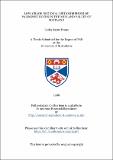Files in this item
Low-grade regional metamorphism of paleozoic rocks in the Midland valley of Scotland
Item metadata
| dc.contributor.advisor | Oliver, Grahame John Henderson | |
| dc.contributor.author | Evans, Lesley Jayne | |
| dc.coverage.spatial | [ca 450] p. | en_US |
| dc.date.accessioned | 2018-07-17T10:35:25Z | |
| dc.date.available | 2018-07-17T10:35:25Z | |
| dc.date.issued | 1988-07 | |
| dc.identifier.uri | https://hdl.handle.net/10023/15467 | |
| dc.description.abstract | Low-grade burial metamorphism in the Midland Valley of Scotland, has been investigated with reference to the Silurian sediments and to the Carboniferous volcanics. In the Silurian sediments, facies definitive phyllosilicates are absent. Thin-section examination indicates that cementation was early and despite strong deformation, the lack of cleavage is related to the isotropic dispersal of domains during burial. Scanning electron microscopy and X-ray diffraction define clay mineral assemblages which characterize the transformation of montmorillonite to illite during burial. Illite crystallinity, bo and conodont alteration, show values consistent with this transformation and are indicative of diagenetic/anchizone conditions. Metamorphism is related to Siluro-Devonian syn-sedimentary burial. Despite tentative links between the Midland Valley and the Southern Uplands during the Llandovery, the relative simplicity of the burial metamorphic sequence in the former region suggests that the Silurian trough became palaeo-geographically distinct. The Carboniferous volcanics have undergone burial metamorphism in the zeolite facies, which occurred once the bulk of the lavas had been extruded, and following burial beneath the Central and Ayrshire Basins. Alteration was dominated by hydrothermal processes and has resulted in the production of early greenstones, later burial metamorphic zones and palaeo-geothermal plumes. Seven zones have been defined upon the distribution of amygdale minerals. Thin-section examination however divides the zeolite facies in the Midland Valley into an upper analcime and a lower laumontite zone. Mineralogical assemblages are conducive with metamorphism at a) Pfluid = 2-4 kb at 200 °C and b) Pfluid = 2 kb at 350-420 °C, for the zeolite zones and the palaeo-geothermal plumes respectively. These values are compatible with burial depth estimates, with homogenization temperatures in fluid inclusions and with calcite-water fractionation temperatures. Water/rock ratios indicate that metamorphism was related to the flow of seawater and meteoric water through the volcanic sequences. Evidence for episodic boiling in fluid inclusions indicates fluid convection occurred, and was related to fracturing associated with a change from a lithostatic to a hydrostatic pressure regime. Seismic pumping was related to fracturing and to renewed magmatic activity in shallow chambers beneath the Midland Valley. | en_US |
| dc.language.iso | en | en_US |
| dc.publisher | University of St Andrews | |
| dc.subject.lcc | QE475.P2E9 | |
| dc.subject.lcsh | Metamorphic rocks | |
| dc.title | Low-grade regional metamorphism of paleozoic rocks in the Midland valley of Scotland | en_US |
| dc.type | Thesis | en_US |
| dc.contributor.sponsor | Natural Environment Research Council (NERC) | en_US |
| dc.contributor.sponsor | Russell Trust | en_US |
| dc.type.qualificationlevel | Doctoral | en_US |
| dc.type.qualificationname | PhD Doctor of Philosophy | en_US |
| dc.publisher.institution | The University of St Andrews | en_US |
This item appears in the following Collection(s)
Items in the St Andrews Research Repository are protected by copyright, with all rights reserved, unless otherwise indicated.

